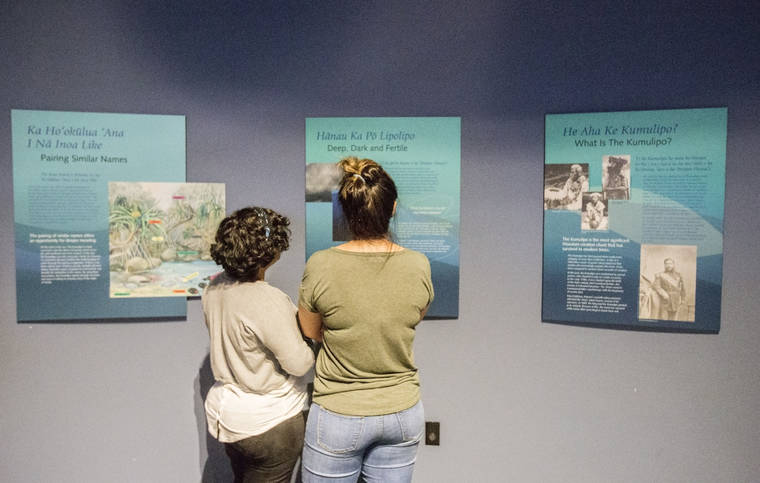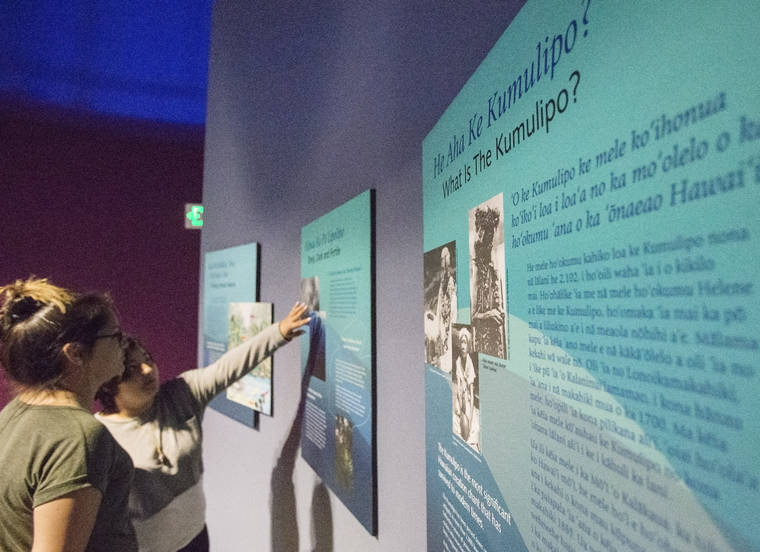Contention continues over the development of the Thirty Meter Telescope atop Maunakea — a debate that is sometimes pitted as science versus Hawaiian culture.
But on Thursday, science and culture converged in Hilo as a sold out and overflowing audience slowly filled ‘Imiloa Astronomy Center’s planetarium for a presentation about “The Physics of Po and the Po of Physics.”
Led by Larry Kimura, associate professor of Hawaiian language and Hawaiian studies at the University of Hawaii at Hilo, and Doug Simons, executive director of the Canada-France-Hawaii Telescope, the discussion highlighted the intersection of astronomy and Hawaiian culture by examining the first 11 lines of the Kumulipo, a Hawaiian creation chant, and its correlation to the scientific timeline of the universe and its creation.
With more than 2,000 lines of text, the Kumulipo tells of a fathomless source of power (deep darkness) that evolves increasingly into complex life forms. It has been compared to ancient Greek accounts of creation.
“The ‘Imiloa Astronomy Center was born from the confluence of parallel trends — the movement to revitalize Hawaiian language and culture and bring it to the forefront here in Hawaii, coupled with the revolution in our understanding of the universe, enabled by the Maunakea observatories,” said Executive Director Ka‘iu Kimura, Larry Kimura’s niece, in her introduction at the start of the program.
She said that more than two years ago, businessman John DeFries brought many people together around the concept of naming celestial objects, a project now known as A Hua He Inoa, which allowed community members to look at these astronomical discoveries from Hawaiian and astronomical perspectives.
As a result of those conversations, Larry Kimura and Simons “were able to explore beyond naming and go all the way back to the very beginning of time, the beginning of our universe. And that is what brought us here this evening.”
Simons told the audience that early in those discussions, he and Kimura were “making a connection over Po,” a darkness and source of creation.
His first lesson Thursday, though, was the idea of science and culture not just co-existing, but “this is really an attempt to bring them together and form something called knowledge, basically. And it’s not an attempt to keep them separate, as I think is the paradigm these days.”
Simons said when he first read Kimura’s translation of the beginning lines of the Kumulipo, “what’s going through my head is the astrophysics that it’s implying” and how it came to be the genesis chant 1,000 years ago in Hawaii. It’s “sort of chicken skin material.”
He immediately began asking “some fairly deep questions,” like, “why in the world and how in the world, for example, (did) they come up with the first line in the Kumulipo: ‘When fundamental space … altered through heat,’” Simons said.
Kimura said he couldn’t answers questions posed by Simons, “because I wasn’t there when our people put these thoughts together. I can only guess, so I’m saying to Doug, ‘I should be asking you those same questions because you probably have better answers than me about how did they think about this.’”
When his and Kimura’s expertise intersects, Simons said, “we are coming (at it) from very different angles. And I’m almost blind to his understanding, and he’s blind to mine, so that makes it really fun as we’re going back and forth to try and figure out what Po is in our little adventure here.”
Following the presentation, Simons said he hoped the takeaway Thursday would be a“thought-provoking experience that leads (the audience) to their own conclusions, based upon whatever I stirred inside.”
“As I said before, I’m trying to make an emotional connection as much as an intellectual one and allow people to kind of explore the concepts and take them where ever they want to take them,” he said. “I don’t answer all the questions, I just sort of lay out all this information and link it back to the Kumulipo.”
But the most important thing is that the A Hua He Inoa program, “just beautifully interweaves the science and the culture,” Simons said.
The possibility of “hybridizing” to create something different “is an opportunity that can apply to all kinds of fields of science, many different cultures, and in Hawaii, we can lead the world in this sort of new view plane, if you will, of science and culture. … But it’s just another way where here in Hawaii, because the culture and the astronomy community on the Big Island are intertwined already, we can sort of show the world how it’s done, so to speak, and hopefully benefit indigenous cultures elsewhere.”
When asked about the importance of this presentation now, in the wake of ongoing protests against TMT, Simons said the Po discussion “was never planned to be now.”
“We weren’t quite sure if we would do it, to tell you the truth. I’m glad we did,” he said. “I think the juxtaposition of what’s occurring in the conflict over Maunakea in this presentation provides some really interesting contrast. …
“I just hope people are open in their mind and their heart to the possibility that through this whole program (A Hua He Inoa), you can create and evolve both the science and the culture into the future.”
Simons said they will give this presentation several times throughout the course of the year and hopes to do it in January in Honolulu.
Email Stephanie Salmons at ssalmons@hawaiitribune-herald.










